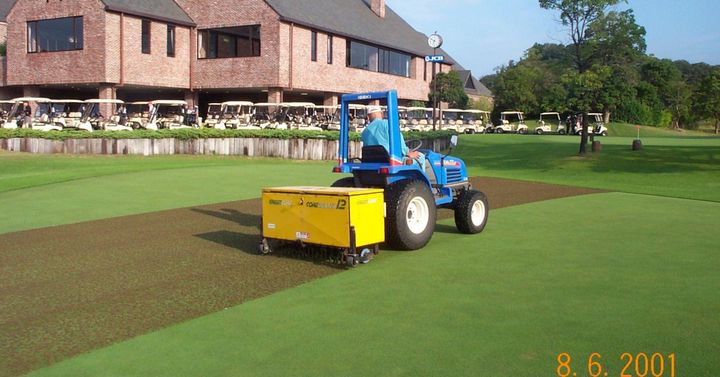No core aeration, no deep verticutting, and surprise! No summer decline
 6 mm hollow tine cultivation of Penncross greens at Habu CC in August
6 mm hollow tine cultivation of Penncross greens at Habu CC in AugustPerspective. It’s funny how that works.
When I first read this research report in 2011, I skimmed over some parts, and cherry-picked what I was looking for — that 15 to 20% surface area removal was required every year in order to keep soil organic matter under control.1 And that’s what I remembered for nine years, that the research from Virginia, the Ervin and someone else article about coring in TERO, Organic matter dilution programs for sand-based putting greens, demonstrated that coring is necessary.
Last summer, I read the same article again. And while the printed words are the same as they were in 2011, my perspective nine years later was different.
This paragraph from the results section jumped out at me, and I put a couple phrases in bold text.
Visual quality ratings at various dates in 2008 and 2010 show that the control plots (sand topdressed only) did not suffer summer decline as might be expected without core aeration or deep verticutting for three consecutive years. Statistically, the control plots finished with the greatest thatch/mat organic matter (4.3%), but this 0.5 to 1% increase compared to more aggressive treatments, did not result in lower visual quality.
Some of you might recall the article I shared last summer about hollow-tine cultivation and solid-tine spiking both failing to alleviate summer bentgrass decline in North Carolina. “Oh, those were new greens, was on research plots and not a golf course, I’ll keep doing what I’ve been doing, thank you very much” was the general response.
That’s fine. I’m all for doing what is working.
But I also find it interesting to look at things with a new perspective. And when I did, reading Ervin and Nichols again, I read that “our research was done on 10-year-old ‘Penn A-4’ practice putting greens at the Independence Golf Club, near Richmond, VA.” This, then, is a surprising result but on greens of medium age and on a golf course. I’m glad I read it again.
Now I’d call that a surrogate marker, or an example of Goodhart’s law because what we really want is not to maintain an organic matter level in the soil, but to produce a certain level of turf performance. ↩︎